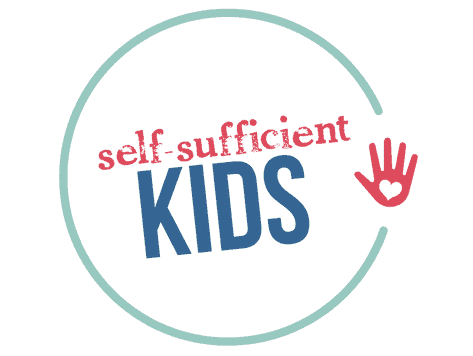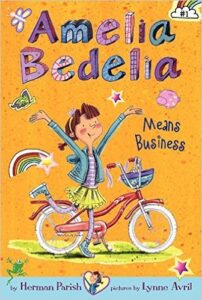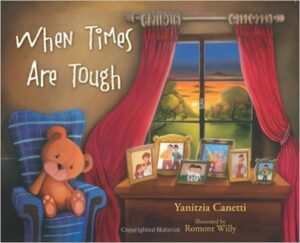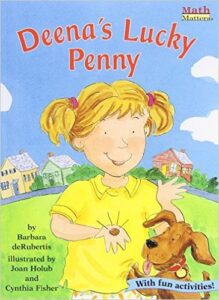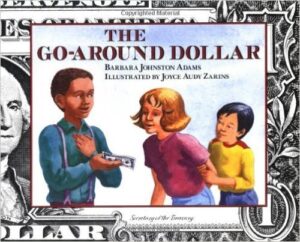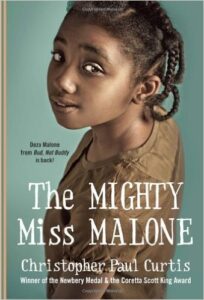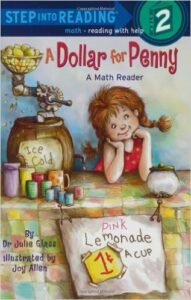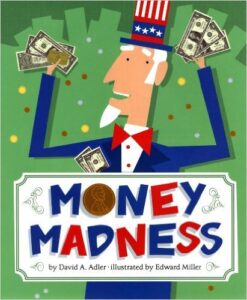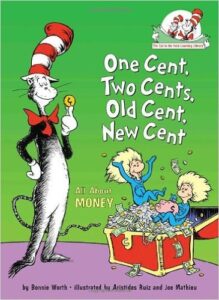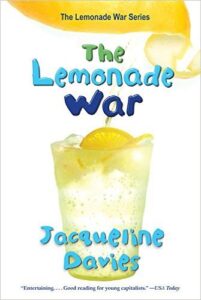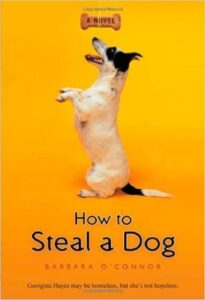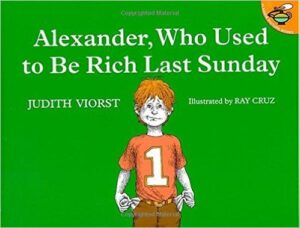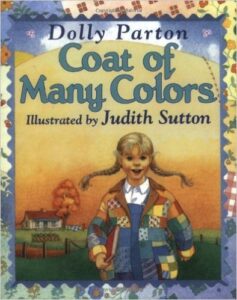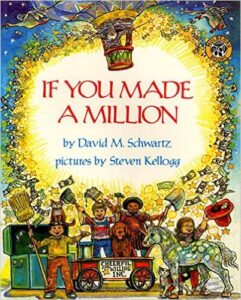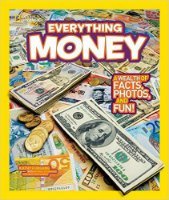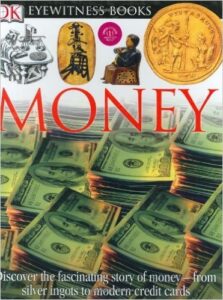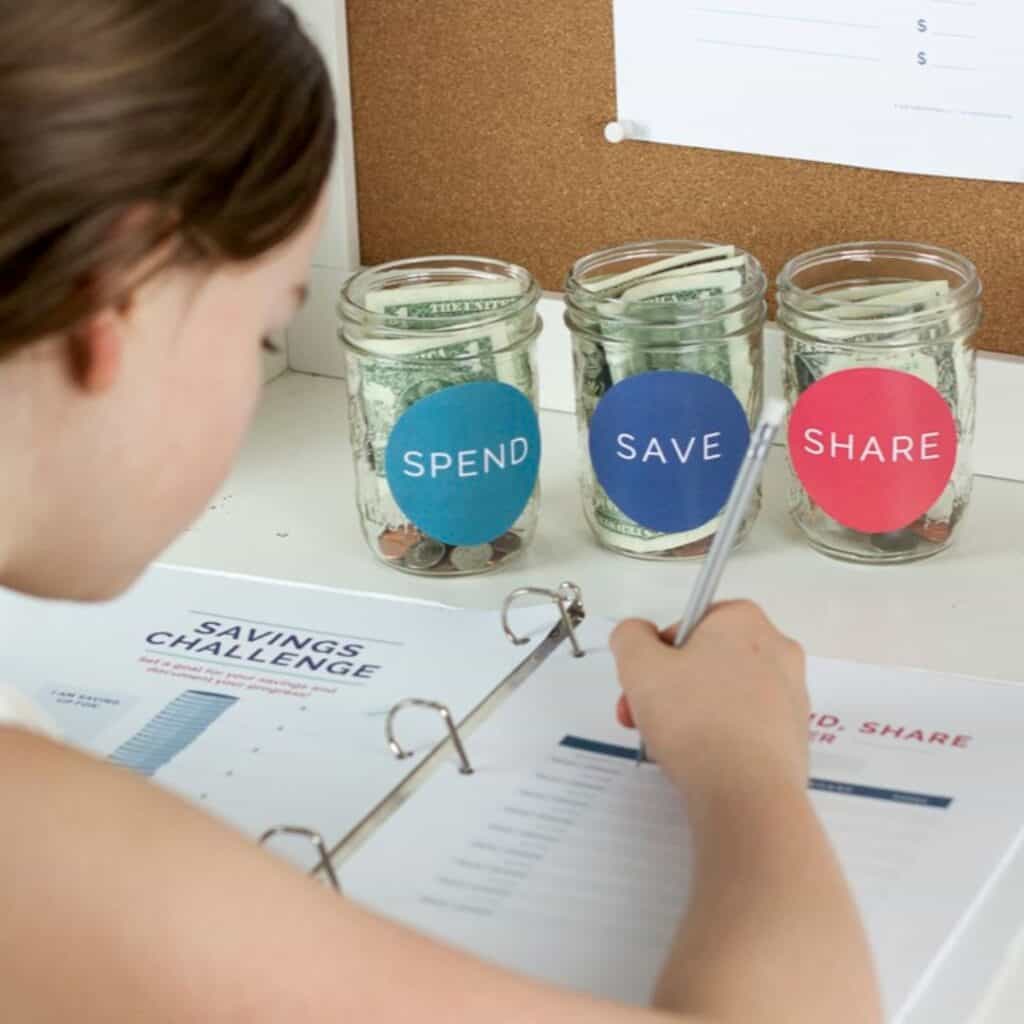28 Children’s Books About Money
These 28 children’s books about money feature fun & engaging stories kids will love.
My girls love books. Shortly after dinner my little one will often ask: “Mom, can you read me a book?” as my oldest either grabs her own book or listens along to my reading. I love that snuggle time with them and will miss it when they’re older!
My girls also love going to the library, and we’re usually able to fit in one trip a week, but many times the books they pull off the shelves are far from the type of book or message I want them to read.
So in a desire to find higher quality books, I’ve begun taking out books from the New York Public Library’s 100 Great Children’s Books, 100 Years. As the name implies, this list showcases what NY public librarians think are the best children’s books written over the past 100 years. It’s an alphabetical list and we’ve only reached the “C” books, but so far so good!
This got me thinking: Why don’t we start reading children’s books about money?
After doing a little research we took out least 50 children’s books about money from our public library. Below is a list of our favorites. You can either check these books out of your local library, buy them at a local bookstore, or click on the Amazon affiliate links embedded in this post (both the book cover photos and book titles have links) to purchase them online.
And now for our favorite children’s books about money:


Lemonade in Winter: A Book About Two Kids Counting Money, by Emily Jenkins & G. Brian Karas, ages 3-7: Pauline and her brother John-John discover how difficult it is to sell lemonade during a winter storm. Their adventure covers counting money, the need to advertise, offer discounts, and determining if money was made or lost from the siblings’ venture. The silliness of this story keeps kids interested.

Those Shoes, by Maribeth Boelts, ages 5-8 years. Everyone at school has purchased a pair of “those shoes” – black high tops with white stripes. But Jeremy’s family can’t afford a new pair of shoes, let alone “those shoes”, even though his are worn out. This story has a touching twist at the end that illustrates the message “it’s better to give than to receive.”

Rock, Brock and the Savings Shock, by Shelia Bair, ages 7-10: Rock and Brock are twin brothers who have been given a gift from their grandfather: each gets a dollar a week and if that dollar and any savings are kept throughout the week, that amount is doubled. One twin does well, the other not so much. A good illustration of the benefits of saving, compound interest, and why spending on a whim can be foolish.

A Chair For My Mother, Vera B. Williams, ages 4-8 years: A girl, her mother, and grandmother save their spare change in a glass jar in order to save for a comfortable chair after losing their furniture in a fire. This book is a classic and also on the New York Public Library’s 100 Great Children’s Books list.

How I Learned Geography, by Uri Shulevitz, ages 4-8 years: Based on a true story, a young boy leaves his home country behind as a refugee. The story talks about the hardships his family faces trying to get food and basic needs, but the boy finds delight in the purchase of a map.

Joseph Had a Little Overcoat, by Simms Taback, ages 3-7: Joseph makes his old overcoat last by transforming it into a variety of different clothing. Teaches kids resourcefulness.

The Penny Pot, by Stuart J. Murphy, ages 7 and up: This book intertwines the fun of kids getting their faces painted at a school fair with seeing if they have 50 cents to pay for it. The book also includes a sweet side story of kids donating their extra pennies to help a girl who doesn’t have quite enough change.

Follow the Money!, Loreen Leedy, ages 5 and up: This book takes the reader through the life of a quarter – how it’s made and can be passed from customer to shopkeeper, employer to employee, and even donor to a charity. The story can be a bit confusing at times and needs a bit of explanation, but kids think it’s funny.

The Money We’ll Save, by Brock Cole, ages 4-8: The mother of a tenement family needs two eggs and half a pound of flour to make dinner tonight, so she sends her husband to the market. He does well at avoiding temptations since the family is saving for Christmas, but at the advice of a seller, the husband purchases a turkey poult for a small sum so the family can raise and eat it for Christmas dinner. The purchase turns out to be more than the family bargained for. A good example of the hardships of tenement life with great illustrations.

Arthur’s Funny Money, by Lillian Hoban, ages 4-8: Arthur decides he wants to buy a t-shirt and cap, but he doesn’t have enough money. His little sister, Violet, comes up with the perfect business idea to make money, but the pair run into a few bumps along the way to make their $5.25. This book shows what it takes to run a business including costs, advertising, and profit.

A Smart Girl’s Guide: Money, by Nancy Holyoke, ages: 10 and up: Apart of the American Girl series fo books, A Smart Girl’s Guide: Money takes girls through the ins and outs of money including making money, smart shopping, credit cards, saving money, and ideas for how to make money.

Making Cents, by Elizabeth Keeler Robinson, ages 5-8: a group of neighborhood kids want to build a clubhouse and raise the money through yard sales. This book demonstrates what the kids can buy with their earned money to build the clubhouse.

Amelia Bedelia Means Business, by Herman Parish, age 6-10: A girl at Amelia’s school just bought a bike that Amelia thinks is the most beautiful bike in the world. Amelia decides she wants one too, but her Mom says it’s too expensive, so Amelia sets out to earn the money on her own.
When Times Are Tough, by Yanitzia Canetti, ages 5-8 years: This book follows a family as they experience tough times financially. It does a nice job of addressing some of the hardships faced from a kids perspective, such as not being able to buy clothes or toys, but then highlights the positives that come out of these hardships such as turning old clothes into something new and using creativity to make new toys.
Deena’s Lucky Penny, by Barbara de Rubertis, ages 7 and up: Deena finds a penny in the grass and it “magically” grows into one dollar that she uses to purchase a birthday gift for her mother. I like how this book teaches kids about coins, but I didn’t love the message of money “magically” appearing.
The Go-Around Dollar, by Barbara Johnston Adams, ages 6-9: Two boys find a dollar bill on the ground. One of them uses the dollar to buy shoelaces from the other. The story shows part the lifecycle of the bill from that point on. The book includes facts about dollar bills that could be interesting for older kids, but will be lost on younger kids.
The Mighty Miss Malone, by Christopher Paul Curtis, chapter book, ages 9-12 years: It’s the Great Depression in Gary, Indiana and jobs are scarce – especially for black men like Mr. Malone. After their father leaves Gary to find work, the rest of the Malone family sets out to catch up with him, including Deza who takes her family’s difficult journey with stride, giving her the name Mighty Miss Malone.
A Dollar for Penny, by Dr. Julie Glass, ages 4-6: A good book for emerging readers. A little girl hosts a lemonade stand. First she charges a penny per cup, but then increases the price a few times educating readers about different types of money: pennies, nickles, quarters and a dollar.
Money Madness, By David A. Adler, ages 5-9: This book answers questions about money: What is money for? Why do we have it? What is it used for? Money Madness also shows the history of money and how it came to be. This book also touches on foreign currency, foreign exchange rates, credit cards, and digital money.
One Cent, Two Cents, Old Cent, New Cent, by Bonnie Worth, ages 4-8: One in a series of Cat in the Hat books meant to teach kids a variety of subjects. This book looks at what life was like before money existed (bartering), how physical money came to be, how different countries designed early money, how money is made, savings accounts, and interest.
The Lemonade War, by Jacqueline Davies, ages 7-10: Evan Treski is people-smart while his younger sister, Jessie is math-smart, but not especially good with people. So when the siblings’ lemonade stand war begins, there’s no telling who will win. This book contains marketing tips for making money, definitions of business terms, charts, diagrams, and math problems.
How to Steal a Dog, by Barbara O’Connor, chapter book, ages 8-12: Georgina Hayes is desperate. Ever since her father left and they were evicted from their apartment, her family has been living in their car. With her Mom juggling two jobs and trying to make enough money to find a place to live, Georgina is stuck looking after her younger brother, Toby. But when Georgina spots a missing-dog poster with a reward of five hundred dollars, the solution to all her problems suddenly seems within reach.
Alexander, Who Used to Be Rich Last Sunday, By Judith Viorst, ages 4-8: Alexander is given a dollar from his grandparents on Sunday. Even though he wants to save it, temptation lures him to spend which makes him grumpy.
Coat of Many Colors, by Dolly Parton, ages 4-8: Dolly Parton tells the story of how her mother sewed her a special coat made out of rags, since her family didn’t have a lot of money. Parton ties the Bible story of Joseph and his coat of many colors into her story.
Bunny Money, by Rosemary Wells, ages 3-6: Max and Ruby go into town intending to buy their grandmother a present, but before they know it, they’ve spent most of their money in other stores.
If You Made a Million, by David M. Schwartz, ages 4-8: Teaches kids about coins, dollars, the value of money, interest, checks, banks, and finally, that making money means making choices.
National Geographic: Everything Money, by Kathy Furgang, ages 8-12: This book provides a good overview of money: it’s history, how money works, what it’s like to be a billionaire, money in the digital age, cost of living comparisons, and donating money. Like all the National Geographic books in this children’s series, kids will enjoy the many pictures, facts, and stories.
DK Eyewitness Books: Money, by Joe Cribb, ages 8-12: Like most Eyewitness books, this one is full of facts. A good book for older elementary kids interested in in-depth learning about money or who are writing a report about money.
The Kids Money Management Toolkit has everything you need (except money!) to begin giving your kids an allowance. In addition to guidance and advice, you’ll also receive Save, Spend, and Share jar labels, a Kids Money Ledger, a Savings Challenge Sheet, a Jobs-for-Hire Sheet, and a Kids Allowance Contract. Click here to learn more.
You may also like:
15 Children’s Books That Promote a Growth Mindset
